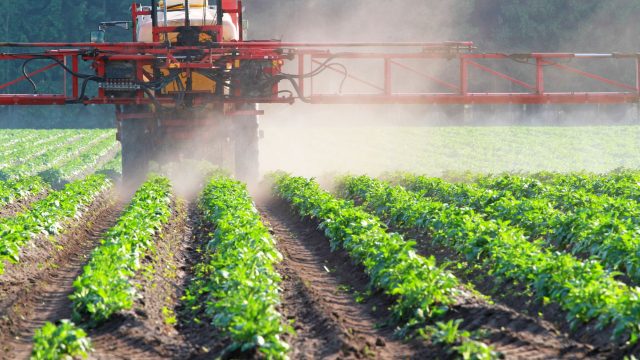02
Nov
Chemicals Added to Herbicides to Reduce Drift Actually Drift Themselves, Are Significant Air Pollutants

(Beyond Pesticides, November 2, 2022) Inert ingredients called “amines” that are added to pesticides in attempts to reduce drift and volatility are themselves highly volatile and may represent a significant source of air pollution, according to research recently published in Environmental Science and Technology. The findings and implications for public health are unexpected, as research until now has not considered herbicide use as a source of amine emissions. “Researchers have looked at industrial applications, animal operations and environmental sources of amines, but no one has looked at herbicides at all, as far as we have seen, despite the fact that large quantities of herbicide-amine mixtures are being sprayed onto crops across the country,” said study author Kimberly Parker, PhD, of Washington University in St Louis (WUSL). “We were really surprised to see that this source had been overlooked.”
Amines are chemical compounds derived from ammonia and often added to herbicide formulations for glyphosate, dicamba, and 2,4-D products to increase solubility and reduce volatilization. In theory, amines reduce volatilization by forming herbicide-amine salts which lock the herbicide vapors in place. However, the team of scientists conducting this research had previously found evidence that even new forms of dicamba billed by the agrichemical industry as “low volatility,” and restricted to formulations that include very specific amines, continued to cause drift problems for farmers.
This led first author Stephen Sharkey, a PhD student at WUSL to a question: “If the dicamba is volatilizing, what’s happening to the amine that’s supposed to be there stopping the volatilization process?”
In order to answer this question, researchers conducted an experiment measuring amine and herbicide losses from herbicide-amine salts. Various solutions containing glyphosate, 2,4-D, or dicamba, and combinations of these herbicides along with combinations of different amine compounds were analyzed by placing them in a glass beaker and drying them under a fume hood in the laboratory for 24 hours. After another 24 hours the beakers were then measured to determine lost residues. This process was repeated at different temperatures using a hot plate to replicate warmer conditions.
Initial testing on 2,4-D and the amine dimethylamine at room temperature saw a roughly 25% loss in dimethylamine but no significant loss of 2,4-D. As part of further testing using a process known as thermal desorption gas chromatography-mass spectrometry, researchers were able to measure the amine loss as it volatilized above a glyphosate formulation. Generally, more amines than herbicide residues were lost during the drying process, but this shifted slightly under higher temperatures. With increasing heat, researchers found both higher amine releases, and evidence of increased herbicide volatility, reinforcing earlier studies.
To understand the aggregate impacts of amine volatility, scientists integrated herbicide use estimates from the US Department of Agriculture and US Environmental Protection Agency to model their atmospheric release. With half of glyphosate, 44% of 2,4-D, and nearly 90% of dicamba use employing an amine-based product formulation, the study estimates that herbicide use releases approximately 4,000 metric tons of amines in the US annually. When considering the use of these herbicides in other countries, as US applications account for only roughly 12% of global use, herbicide amine emissions can be compared to the 285,000 metric tons of amines globally recorded as released into the atmosphere each year from other sources, such as industrial manufacturing and livestock emmissions.
“There has been extensive work looking at the different ways in which amines enter the atmosphere. There has been a lot of effort put into understanding where amines come from, but research into its use with herbicides just wasn’t considered before,” said Dr. Parker.
Despite their listing as an “inert” ingredient, amines are toxicologically active substances. Once present in the atmosphere, amine vapors oxidize and form nitrosamines and nitroamines, which are potent carcinogens. Their release and transformation in the atmosphere likewise results in the creation of fine particulate matter that can affect heart and lung health.
While amines may be capturing some of an herbicide in formulation, it is clear through this research that drift is still occurring, merely with a different hazardous compound. Yet again, advocates note that the pesticide industry’s solution to a problem has created a new problem. This continues along the agrichemical industry’s modus operandi: privatize profits while publicizing harm to public health and the environment.
As scientific studies continue to uncover a myriad of novel dangers herbicides and other pesticides present, it has become increasingly evident that an alternative approach is needed. The growth and success of organic regenerative agriculture that does not employ the use of amine formulated herbicides like glyphosate, 2,4-D, and dicamba reveals the most viable path for a sustainable farming future. Help promote an organic future for farming by taking action today.
All unattributed positions and opinions in this piece are those of Beyond Pesticides
Source: Washington University in St Louis press release, Environmental Science and Technology











We can’t survive without bees
November 2nd, 2022 at 6:41 pm